Enhancing the Efficiency of Color Conversion Micro-LED Display with a Patterned Cholesteric Liquid Crystal Polymer Film
Abstract
:1. Introduction
2. Materials and Methods
2.1. Patterned CLC Film
2.2. Device Modeling
3. Results
3.1. Tradeoff in High Concentration QD Film
3.2. Performance Improvement by the Patterned CLC
3.2.1. Color Conversion Efficiency
3.2.2. Color Gamut
3.2.3. Viewing Angle
3.3. Proof-of-Concept Experiment
4. Discussion
5. Conclusions
Author Contributions
Funding
Acknowledgments
Conflicts of Interest
References
- Lin, J.Y.; Jiang, H.X. Development of microLED. Appl. Phys. Lett. 2020, 116, 100502. [Google Scholar] [CrossRef]
- Huang, Y.; Hsiang, E.L.; Deng, M.Y.; Wu, S.T. Mini-LED, Micro-LED and OLED displays: Present status and future perspectives. Light Sci. Appl. 2020, 9, 105. [Google Scholar] [CrossRef] [PubMed]
- Ding, K.; Avrutin, V.; Izyumskaya, N.; Özgür, Ü.; Morkoç, H. Micro-LEDs, a manufacturability perspective. Appl. Sci. 2019, 9, 1206. [Google Scholar] [CrossRef] [Green Version]
- Corbett, B.; Loi, R.; Zhou, W.; Liu, D.; Ma, Z. Transfer print techniques for heterogeneous integration of photonic components. Prog. Quantum. Electron. 2017, 52, 1–17. [Google Scholar] [CrossRef]
- Liu, Z.; Lin, C.H.; Hyun, B.R.; Sher, C.W.; Lv, Z.; Luo, B.; Jiang, F.; Wu, T.; Ho, C.H.; Kuo, H.C.; et al. Micro-light-emitting diodes with quantum dots in display technology. Light Sci. Appl. 2020, 9, 83. [Google Scholar] [CrossRef]
- Lin, H.Y.; Sher, C.W.; Hsieh, D.H.; Chen, X.Y.; Chen, H.M.P.; Chen, T.M.; Lau, K.M.; Chen, C.H.; Lin, C.C.; Kuo, H.C. Optical cross-talk reduction in a quantum-dot-based full-color micro-light-emitting-diode display by a lithographic-fabricated photoresist mold. Photonics Res. 2017, 5, 411–416. [Google Scholar] [CrossRef]
- Chen, H.W.; He, J.; Wu, S.T. Recent advances in quantum-dot-enhanced liquid crystal displays. IEEE J. Sel. Top. Quantum Electron. 2017, 23, 1900611. [Google Scholar] [CrossRef]
- Kim, H.M.; Ryu, M.; Cha, J.H.; Kim, H.S.; Jeong, T.; Jang, J. Ten micrometer pixel, quantum dots color-conversion layer for high resolution and full color active matrix micro-LED display. J. Soc. Inf. Disp. 2019, 27, 347–353. [Google Scholar] [CrossRef]
- Xuan, T.; Shi, S.; Wang, L.; Kuo, H.C.; Xie, R.J. Inkjet-Printed Quantum Dot Color Conversion Films for High-Resolution and Full-Color Micro Light-Emitting Diode Displays. J. Phys. Chem. 2020, 11, 5184–5191. [Google Scholar] [CrossRef]
- Pointer, M.R. The gamut of real surface colours. Color Res. Appl. 1980, 5, 145–155. [Google Scholar] [CrossRef]
- Chu, S.Y.; Wang, H.Y.; Lee, C.T.; Lee, H.Y.; Laing, K.L.; Kuo, W.H.; Fang, Y.H.; Lin, C.C. Improved Color Purity of Monolithic Full Color Micro-LEDs Using Distributed Bragg Reflector and Blue Light Absorption Material. Coatings 2020, 10, 436. [Google Scholar] [CrossRef]
- Zhu, R.; Luo, Z.; Chen, H.; Dong, Y.; Wu, S.T. Realizing Rec. 2020 color gamut with quantum dot displays. Opt. Express 2015, 23, 23680–23693. [Google Scholar] [CrossRef] [PubMed] [Green Version]
- Gou, F.; Hsiang, E.L.; Tan, G.; Chou, P.T.; Li, Y.L.; Lan, Y.F.; Wu, S.T. Angular color shift of micro-LED displays. Opt. Express 2019, 27, A746–A757. [Google Scholar] [CrossRef] [PubMed]
- Tang, Y.; Li, Z.; Li, Z.T.; Li, J.S.; Yu, S.D.; Rao, L.S. Enhancement of luminous efficiency and uniformity of CCT for quantum dot-converted LEDs by incorporating with ZnO nanoparticles. IEEE Trans. Electron Devices 2017, 65, 158–164. [Google Scholar] [CrossRef]
- Chen, C.J.; Lin, C.C.; Lien, J.Y.; Wang, S.L.; Chiang, R.K. Preparation of quantum dot/polymer light conversion films with alleviated Förster resonance energy transfer redshift. J. Mater. Chem. C 2015, 3, 196–203. [Google Scholar] [CrossRef]
- Han, S.; Kiselev, F.D.; Mlejnek, M. Quantum Dots on Color Filter LCD Design Study. Int. Symp. Dig. Tech. Pap. 2019, 50, 1067–1070. [Google Scholar] [CrossRef]
- Gou, F.; Hsiang, E.L.; Tan, G.; Lan, Y.F.; Tsai, C.Y.; Wu, S.T. Tripling the optical efficiency of color-converted micro-LED displays with funnel-tube array. Crystals 2019, 9, 39. [Google Scholar] [CrossRef] [Green Version]
- Chen, G.S.; Wei, B.Y.; Lee, C.T.; Lee, H.Y. Monolithic red/green/blue micro-LEDs with HBR and DBR structures. IEEE Photonics Technol. Lett. 2018, 30, 262–265. [Google Scholar] [CrossRef]
- Han, H.V.; Lin, H.Y.; Lin, C.C.; Chong, W.C.; Li, J.R.; Chen, K.J.; Yu, P.; Chen, T.M.; Chen, H.M.; Lau, K.M.; et al. Resonant-enhanced full-color emission of quantum-dot-based micro LED display technology. Opt. Express 2015, 23, 32504–32515. [Google Scholar] [CrossRef]
- Bai, X.; Yang, H.; Zhao, B.; Zhang, X.; Li, X.; Xu, B.; Wei, F.; Liu, Z.; Wang, K.; Sun, X.W. Flexible Quantum Dot Color Converter Film for Micro-LED Applications. Int. Symp. Dig. Tech. Pap. 2019, 50, 30–33. [Google Scholar] [CrossRef]
- He, J.; Chen, H.; Chen, H.; Wang, Y.; Wu, S.T.; Dong, Y. Hybrid downconverters with green perovskite-polymer composite films for wide color gamut displays. Opt. Express 2017, 25, 12915–12925. [Google Scholar] [CrossRef] [PubMed] [Green Version]
- Yang, D.K.; Huang, X.Y.; Zhu, Y.M. Bistable cholesteric reflective displays: Materials and drive schemes. Annu. Rev. Mater. Sci. 1997, 27, 117–146. [Google Scholar] [CrossRef]
- He, J.; He, Z.; Towers, A.; Zhan, T.; Chen, H.; Zhou, L.; Zhang, C.; Chen, R.; Sun, T.; Gesquiere, A.J.; et al. Ligand assisted swelling–deswelling microencapsulation (LASDM) for stable, color tunable perovskite–polymer composites. Nanoscale Adv. 2020, 2, 2034–2043. [Google Scholar] [CrossRef]
- Lien, J.Y.; Chen, C.J.; Chiang, R.K.; Wang, S.L. Patternable Color-conversion Films based on Thick-shell Quantum Dots. Int. Symp. Dig. Tech. Pap. 2017, 48, 558–561. [Google Scholar] [CrossRef]
- Shin, M.H.; Kim, H.J.; Kim, Y.J. Optical modeling based on mean free path calculations for quantum dot phosphors applied to optoelectronic devices. Opt. Express 2017, 25, A113–A123. [Google Scholar] [CrossRef] [PubMed]
- Zhang, X.; Qi, L.; Chong, W.C.; Li, P.; Lau, K.M. High-Resolution Monolithic Micro-LED Full-color Micro-display. Int. Symp. Dig. Tech. Pap. 2020, 51, 339–342. [Google Scholar] [CrossRef]
- Hu, Z.; Yin, Y.; Ali, M.U.; Peng, W.; Zhang, S.; Li, D.; Zou, T.; Li, Y.; Jiao, S.; Chen, S.J.; et al. Inkjet printed uniform quantum dots as color conversion layers for full-color OLED displays. Nanoscale 2020, 12, 2103–2110. [Google Scholar] [CrossRef]
- Yue, S. Quantum Dot Photoresist for Color Filter application. Int. Symp. Dig. Tech. Pap. 2018, 49, 724–726. [Google Scholar] [CrossRef]
- Yin, Y.; Hu, Z.; Ali, M.U.; Duan, M.; Gao, L.; Liu, M.; Peng, W.; Geng, J.; Pan, S.; Wu, Y.; et al. Full-Color Micro-LED Display with CsPbBr3 Perovskite and CdSe Quantum Dots as Color Conversion Layers. Adv. Mater. Technol. 2020, 5, 2000251. [Google Scholar] [CrossRef]
- Chen, H.W.; Zhu, R.D.; He, J.; Duan, W.; Hu, W.; Lu, Y.Q.; Li, M.C.; Lee, S.L.; Dong, Y.; Wu, S.T. Going beyond the limit of an LCD’s color gamut. Light Sci. Appl. 2017, 6, e17043. [Google Scholar] [CrossRef] [Green Version]
- He, Z.; He, J.; Zhang, C.; Wu, S.T.; Dong, Y. Swelling-Deswelling Microencapsulation Enabled Ultrastable Perovskite-Polymer Composites for Photonic Applications. Chem. Rec. 2020, 20, 672–681. [Google Scholar] [CrossRef] [PubMed]
- Zhang, L.; Ou, F.; Chong, W.-C.; Chen, Y.; Li, Q. Wafer-scale monolithic hybrid integration of Si-based IC and III–V epi-layers—A mass manufacturable approach for active matrix micro-LED micro-displays. J. Soc. Inf. Disp. 2018, 26, 137–145. [Google Scholar] [CrossRef]
- Henry, W.; Percival, C. ILED Displays: Next Generation Display Technology. Int. Symp. Dig. Tech. Pap. 2016, 47, 747–750. [Google Scholar] [CrossRef]
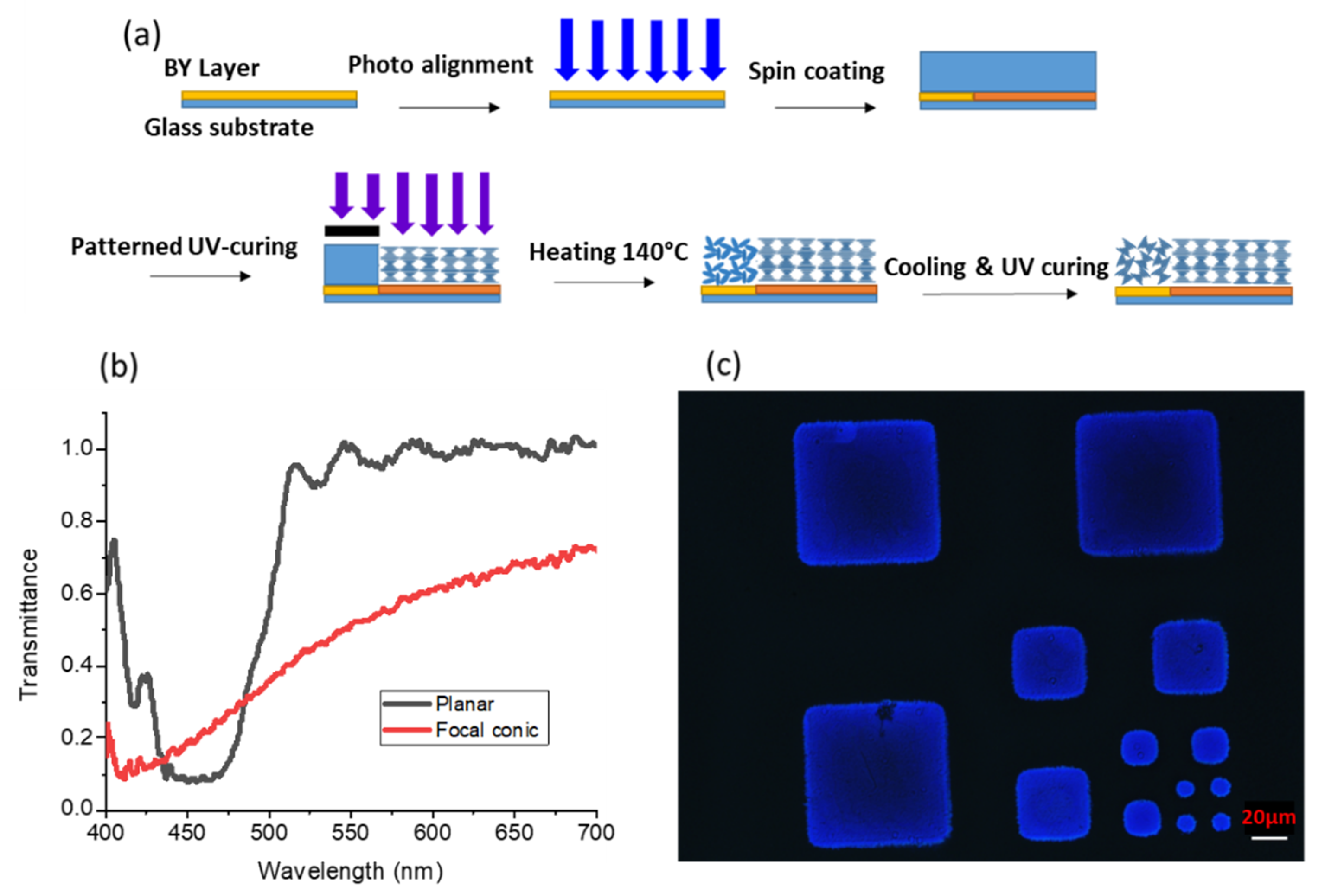
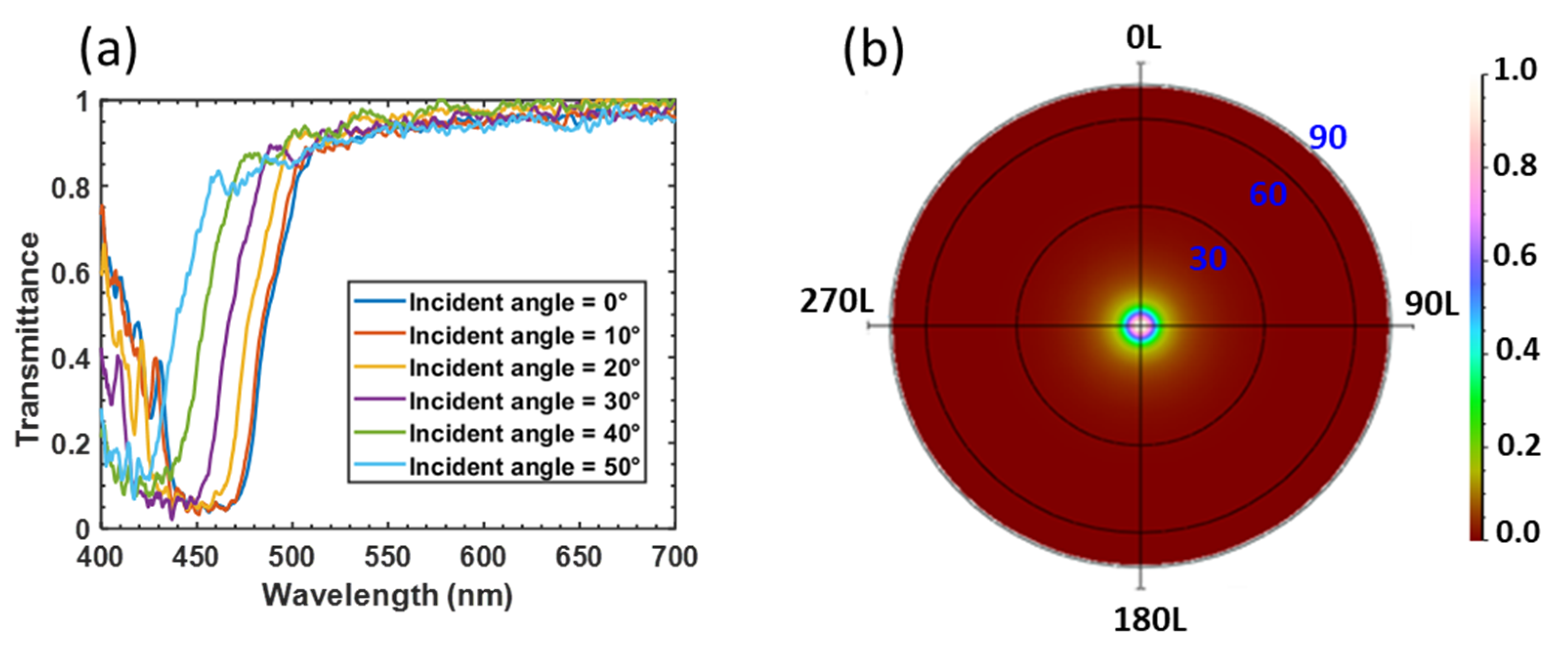
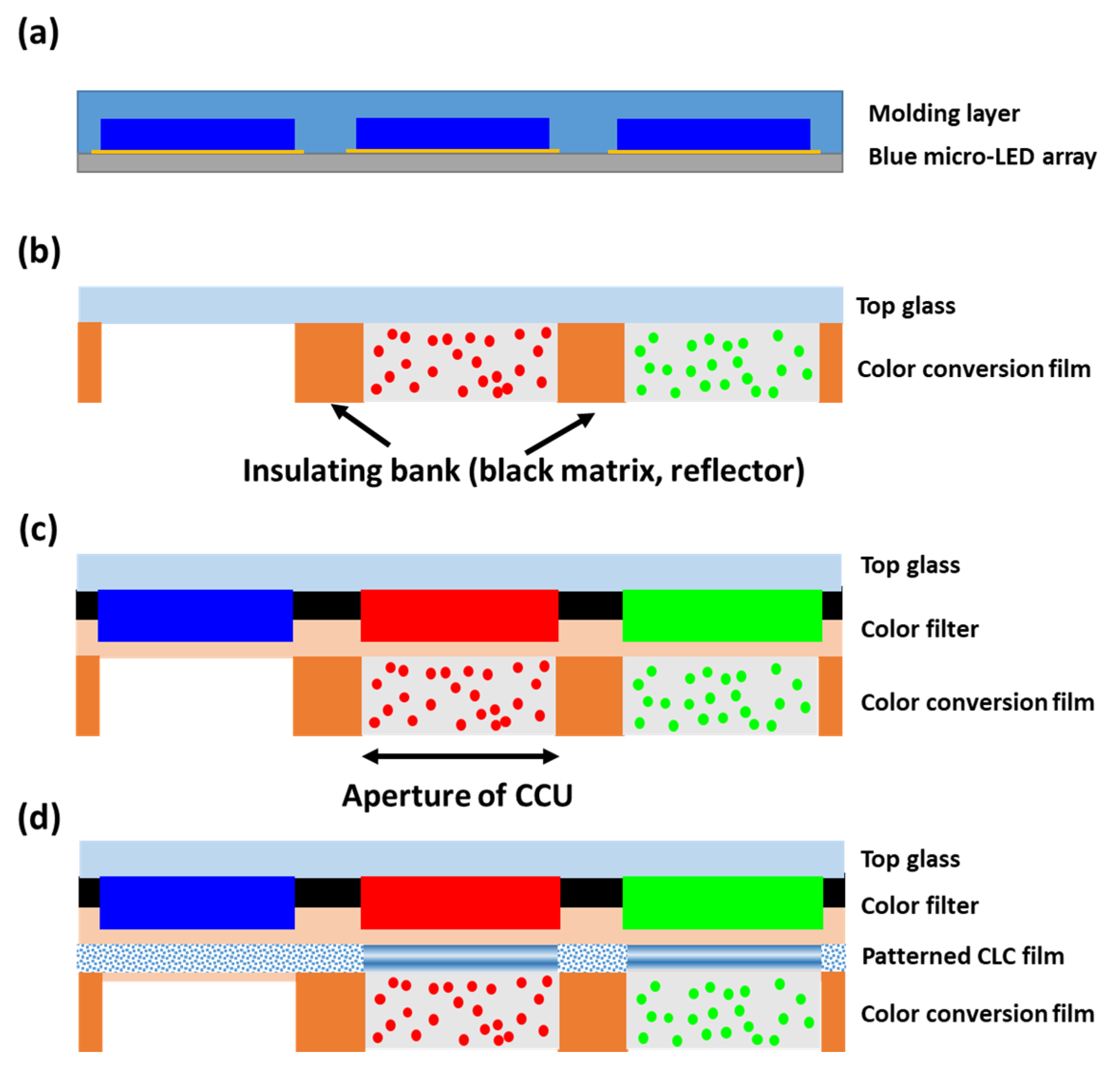
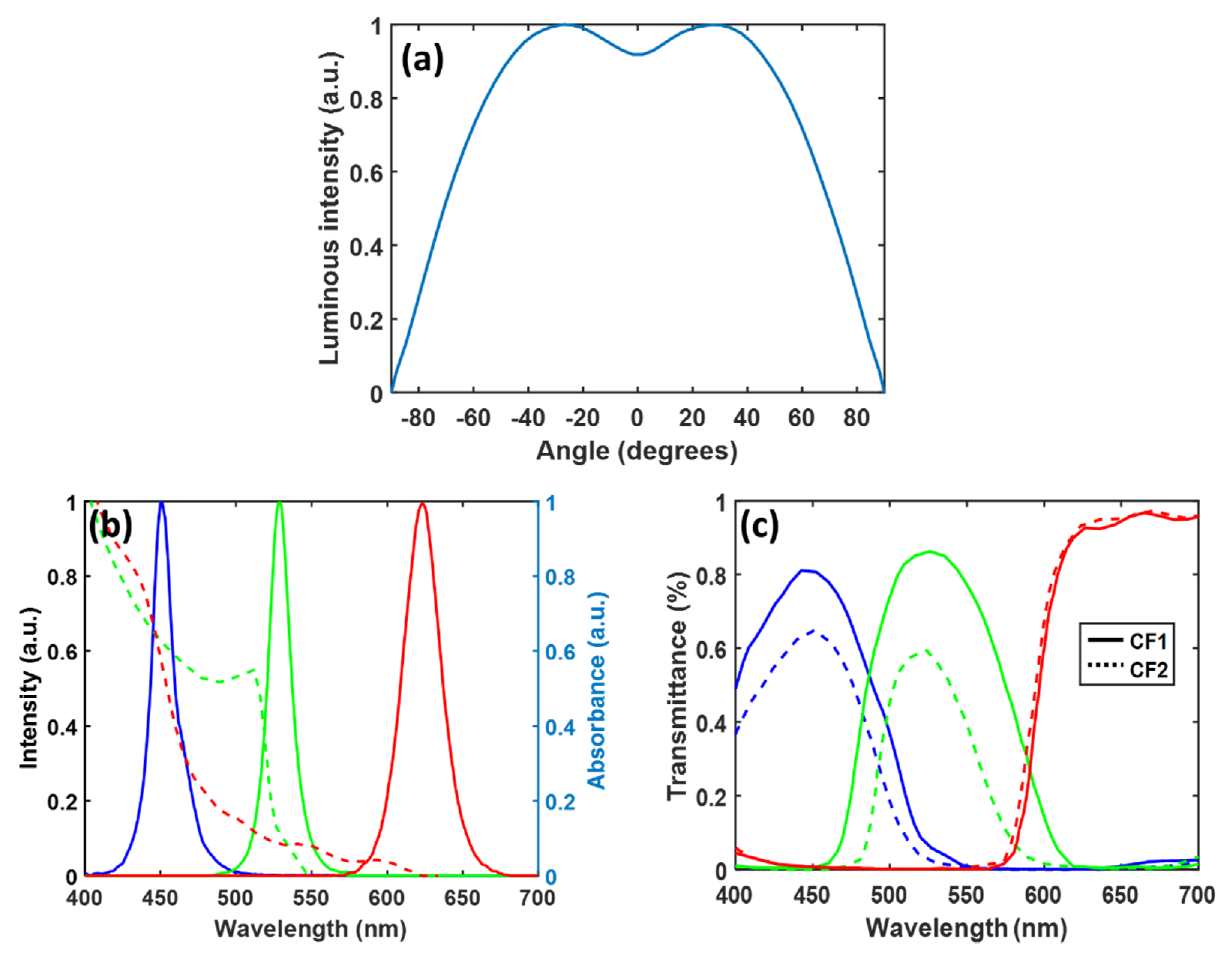
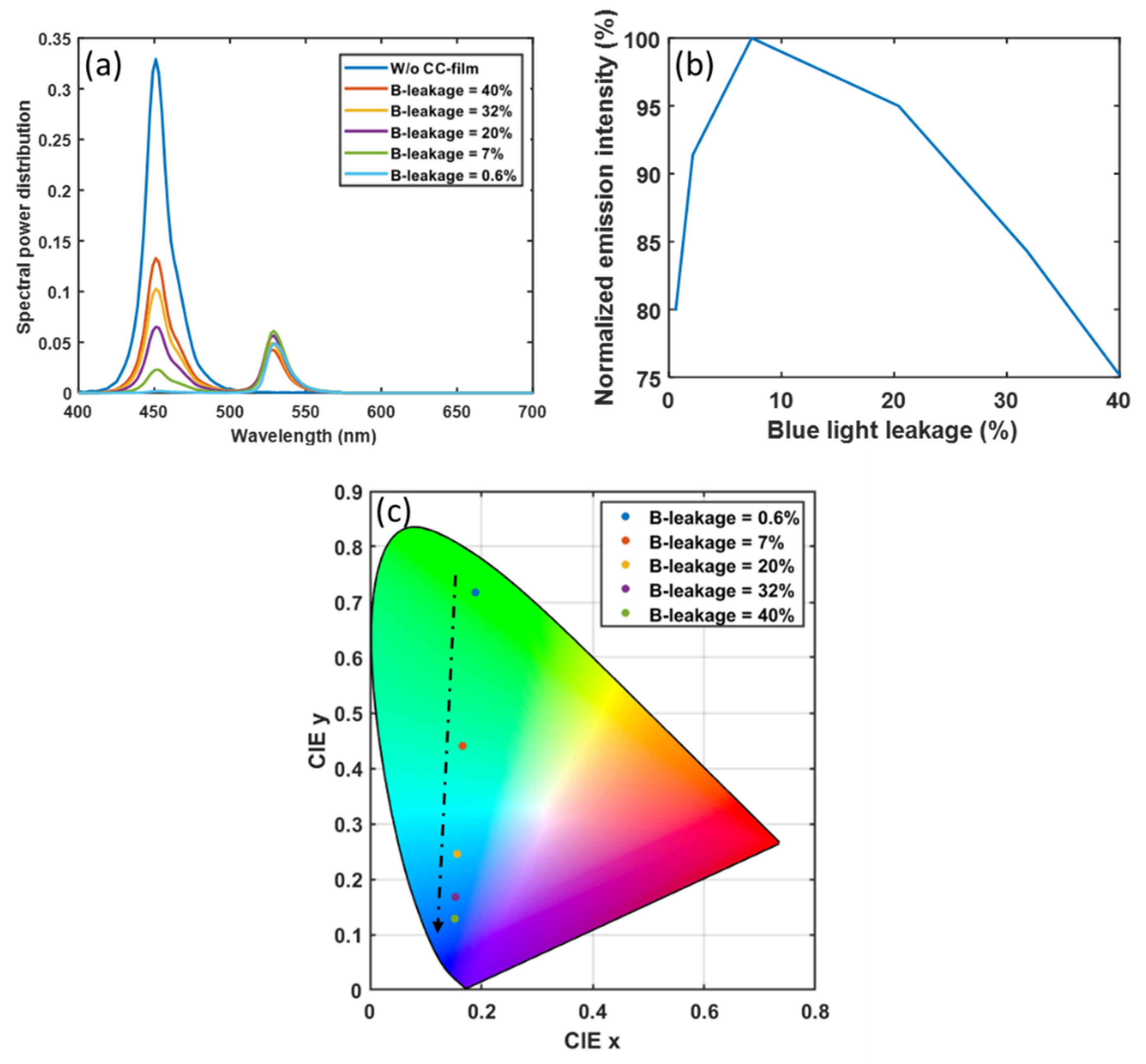


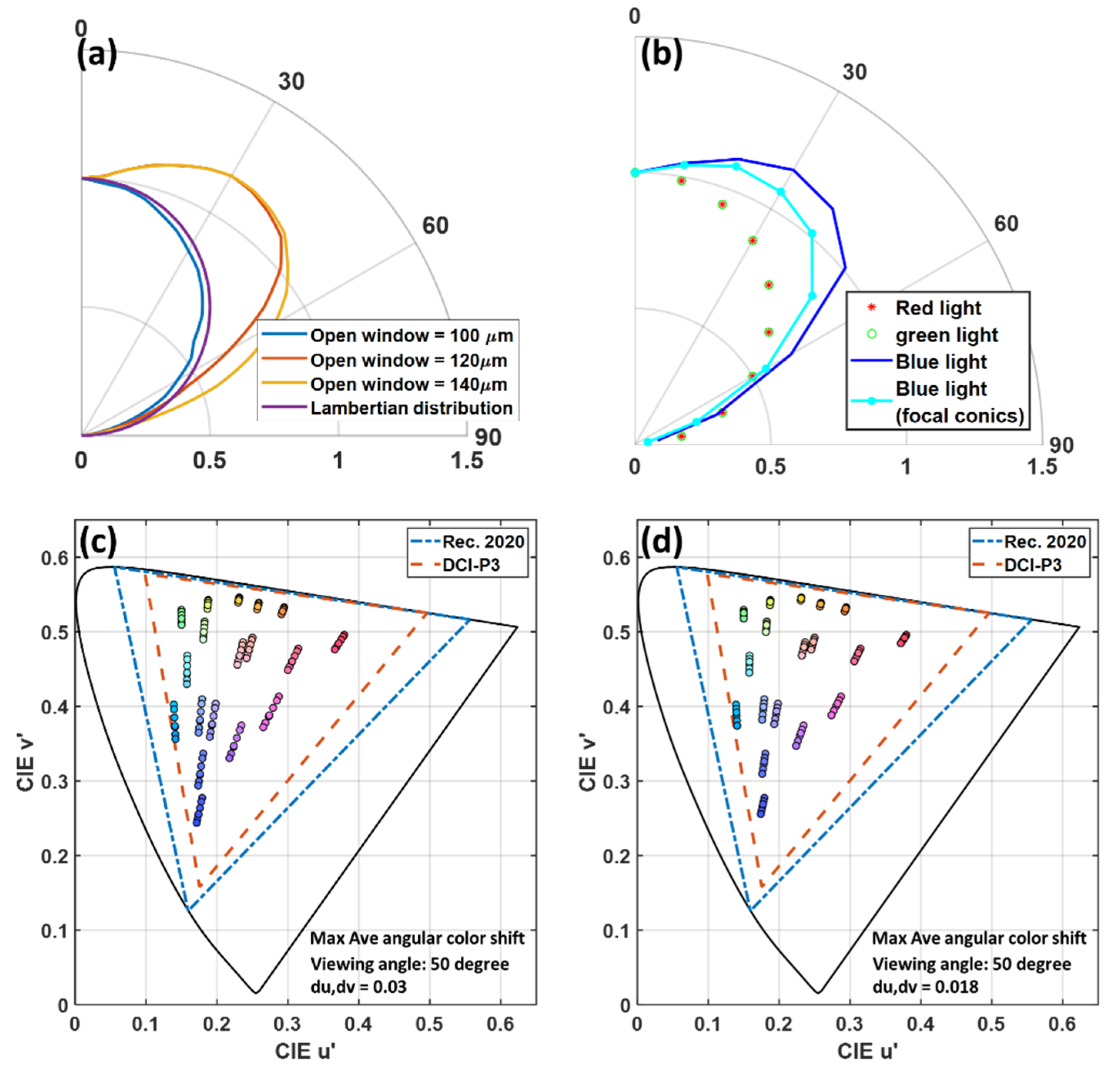
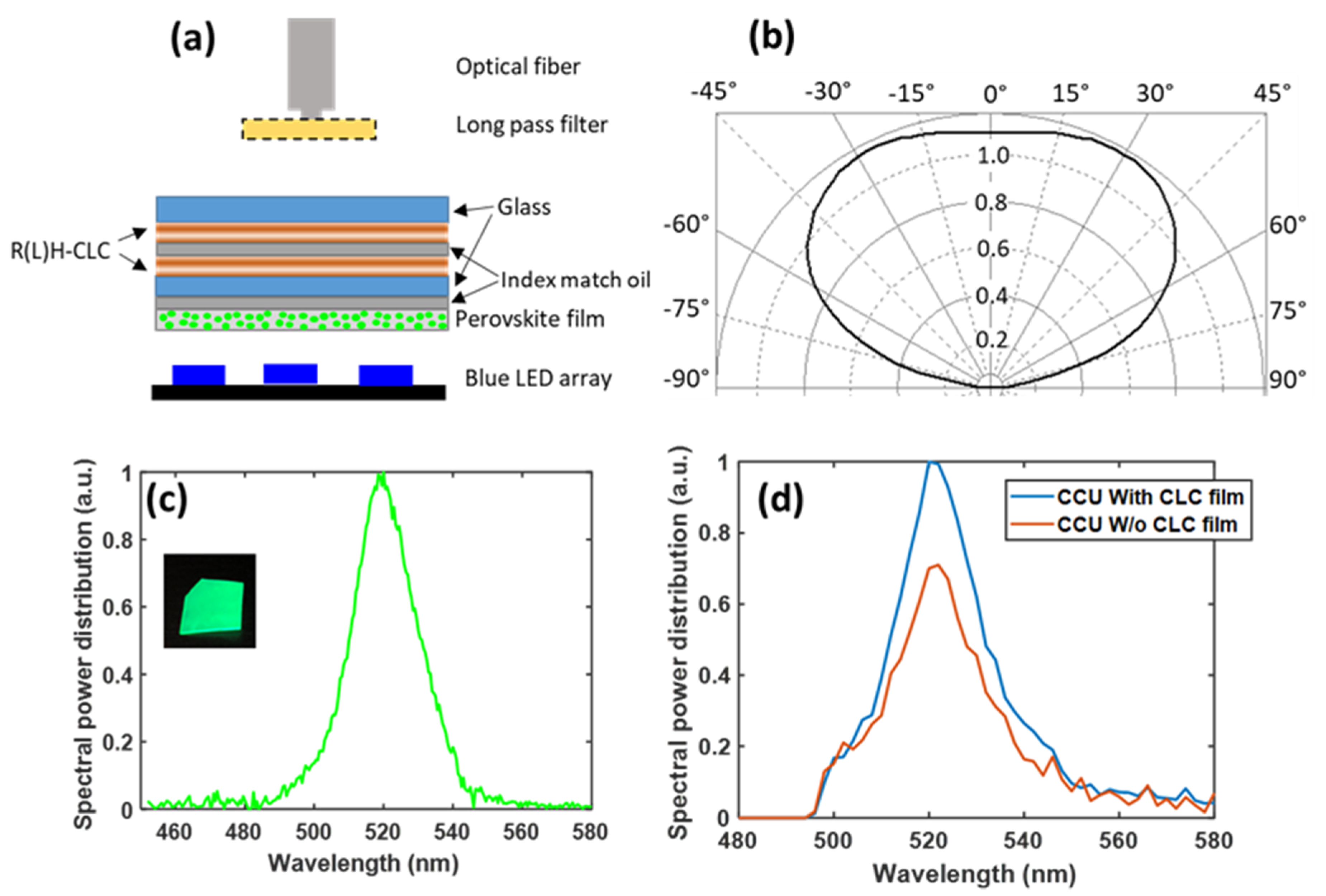
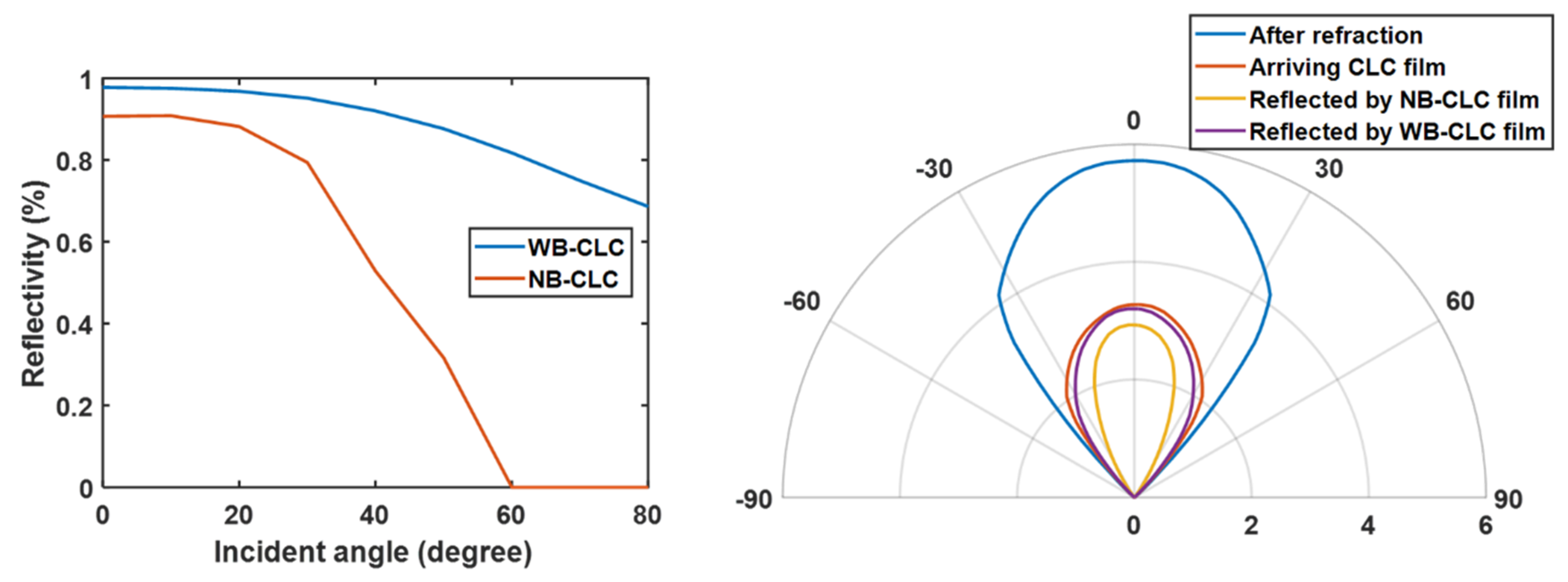
| Material Parameters | 630 nm | 520 nm | 465 nm | |||
|---|---|---|---|---|---|---|
| n | k | n | k | n | k | |
| Molding layer | 1.48 | 0 | 1.49 | 0 | 1.50 | 0 |
| Blue LED chip | 2.34 | 4 × 10−5 | 2.38 | 4 × 10−5 | 2.44 | 4 × 10−5 |
| Glass substrate | 1.5 | 0 | 1.5 | 0 | 1.5 | 0 |
Publisher’s Note: MDPI stays neutral with regard to jurisdictional claims in published maps and institutional affiliations. |
© 2020 by the authors. Licensee MDPI, Basel, Switzerland. This article is an open access article distributed under the terms and conditions of the Creative Commons Attribution (CC BY) license (http://creativecommons.org/licenses/by/4.0/).
Share and Cite
Hsiang, E.-L.; Li, Y.; He, Z.; Zhan, T.; Zhang, C.; Lan, Y.-F.; Dong, Y.; Wu, S.-T. Enhancing the Efficiency of Color Conversion Micro-LED Display with a Patterned Cholesteric Liquid Crystal Polymer Film. Nanomaterials 2020, 10, 2430. https://doi.org/10.3390/nano10122430
Hsiang E-L, Li Y, He Z, Zhan T, Zhang C, Lan Y-F, Dong Y, Wu S-T. Enhancing the Efficiency of Color Conversion Micro-LED Display with a Patterned Cholesteric Liquid Crystal Polymer Film. Nanomaterials. 2020; 10(12):2430. https://doi.org/10.3390/nano10122430
Chicago/Turabian StyleHsiang, En-Lin, Yannanqi Li, Ziqian He, Tao Zhan, Caicai Zhang, Yi-Fen Lan, Yajie Dong, and Shin-Tson Wu. 2020. "Enhancing the Efficiency of Color Conversion Micro-LED Display with a Patterned Cholesteric Liquid Crystal Polymer Film" Nanomaterials 10, no. 12: 2430. https://doi.org/10.3390/nano10122430





